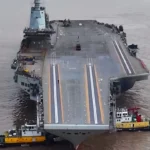Following the 55th Security Consultative Meeting (SCM) in Seoul, U.S. and South Korean defense officials released the Defense Vision of the U.S.-Republic of Korea (ROK) Alliance. It is the second such document, following the 2019 release of the Public Summary of the Future Defense Vision of the ROK-U.S. Alliance after the 51st SCM. A comparison of both is revealing.
Both the 2019 and 2023 defense visions – like most SCM Joint Communiques and South Korea-U.S. leader-level joint statements – ground the alliance in a shared history going back to the Korean War and establishment of the alliance and in shared values and mutual trust.
Additionally, both defense visions are clearly situated in the 2009 Joint Vision Statement’s commitment to broaden the scale and scope of the alliance. This includes going beyond traditional military and security cooperation to include deeper political, economic, cultural, and social ties, as well as expanding the geographic aperture of the alliance beyond the Korean Peninsula to the region and globe. And, while the 2019 and 2023 documents are technically the only two formal “defense visions,” they build upon the earlier 2010 Guidelines for ROK-U.S. Defense Cooperation, which were meant to develop the future direction of the defense relationship based upon the 2009 Joint Vision Statement.
Yet the two defense visions also reflect very distinct geopolitical contexts, a significant shift in inter-Korean relations, and notably varying levels of alliance cohesion. Alongside a quickly evolving international environment, the differences between the documents are driven by the divergent policy priorities and worldviews of the Moon and Trump and Yoon and Biden administrations, respectively. Furthermore, comparing the defense visions highlights persistent and potential future challenges complicating alliance transformation.
From Engagement to Deterrence and Greater Rhetorical Alignment
When viewed side-by-side, the most obvious distinction between the two defense visions is their length. The 2019 document is half the size of the 2023 version. Moreover, the 2019 version includes far less substantive detail. This difference is partly the result of the Biden administration’s tendency to include more detail in such statements to signal the strengthening and broadening of alliances. Yet the 2010 defense guidelines and 2023 defense vision are very similar in length, format, and content, so in this respect the 2019 defense vision deviated from the norm. Therefore, the difference between the 2019 and 2023 documents is also a function of shifting geopolitical circumstances, significant variation in alliance cohesion, and the distinct priorities of the U.S. and South Korean administrations in office at the time of their respective release.
The 2019 version, released in summary form just after the 51st SCM, emerged amid tensions over alliance burden sharing and Seoul’s threat to terminate its bilateral military intelligence-sharing agreement with Japan. Several weeks later, U.S. officials reassured wary observers that alliance fissures were not developing. At that time, U.S. and South Korea policymakers were struggling to navigate then-U.S. President Donald Trump’s highly transactional and dismissive approach toward Seoul – whether in ongoing negotiations surrounding the SMA or the recently renegotiated KORUS free trade agreement – and then-South Korean President Moon Jae-in’s search for greater autonomy within and outside the alliance. Moreover, with North Korea-U.S. diplomacy increasingly stalemated, the Trump and Moon administration’s divergent priorities, never far beneath the surface, came to the fore.
The 2023 defense vision, on the other hand, capped off the year-long celebration of the 70th anniversary of the alliance, marked by a number of historic documents. Furthermore, from the outset, the Biden administration has quickly moved to resolve cost-sharing disputes and stabilize alliance relations. Initially overlapping with Moon (during which alliance cohesion improved), U.S. President Joe Biden ultimately shared more priorities with South Korean President Yoon Suk-yeol, whose campaign platform called for strengthening the alliance on multiple levels. The shifting contexts and more shared priorities are evident in comparing the two defense visions.
First, while all defense-related alliance statements contain a balance between engagement and deterrence regarding North Korea, the pendulum often swings and sometimes severely. The 2019 vision clearly emphasizes diplomacy and engagement. Despite the failed Hanoi Summit in February 2019, Pyongyang’s restart of short-range ballistic missile tests that spring, and the breakoff of working-level North Korea-U.S. talks in Stockholm in September (the month before its release), the 2019 defense vision remains firmly grounded in the policy of inter-Korean and North Korea-U.S. détente.
Alliance defense coordination would, according to the 2019 document, aim to “support the establishment of complete denuclearization in a verifiable manner and a permanent peace on the Korean Peninsula.” Despite negative trends, such engagement-oriented framing still made sense. It matched the Moon administration’s steadfast commitment to engagement. The Trump administration, too, remained officially committed to negotiations if unwilling to meet Pyongyang’s demands. Also, at that time North Korean officials stated denuclearization of the Korean Peninsula was still possible.
The contrast with the 2023 version couldn’t be starker. The 2023 document does not mention denuclearization. Furthermore, while the 2023 document mentions peace, it overwhelmingly emphasizes deterrence. Compared to the 2019 document, which mentions deterrence twice in a generalized manner, the 2023 vision mentions it 12 times, and the object against which deterrence is directed (i.e., North Korea) is much clearer.
The 2019 document mentions threats on a general level, as security, nontraditional, and transnational threats or traditional yet non-descript chemical, biological, radiological, and nuclear (CBRN) threats, but never mentions North Korea. The 2023 vision mentions the DPRK (the abbreviation of North Korea’s formal name) five times, calling it the alliance’s “foundational and most pressing threat,” reflecting the Yoon administration’s reintroduction of the designation “main enemy” for North Korea, a designation his progressive predecessors adjured.
Second, there is clear divergence regarding extended deterrence. While the 2019 vision mentions strengthening extended deterrence and ensuring it “remains credible, capable, and enduring,” such anodyne language is in reference to non-descript CBRN threats. The document doesn’t mention North Korea and leaves out any consultative mechanisms, such as the Extended Deterrence Strategy and Consultation Group (EDSCG). The latter was suspended after only its second meeting in 2018 due to the Moon administration’s drive to promote inter-Korean rapprochement.
The 2023 vision, however, emerged following Pyongyang’s official rejection of denuclearization and its termination of a self-imposed moratorium on ICBM testing. In a context of North Korea’s advancing nuclear and missile capabilities and more aggressive nuclear policy law, increased discussion in Seoul of South Korea’s own nuclear armament or return of U.S. tactical nuclear weapons to the peninsula, and amid concerns about U.S. credibility and capacity, extended deterrence figured much more prominently in the 2023 vision.
The 2023 document contained a U.S. commitment to uphold its extended deterrence commitment based upon the Washington Declaration and strengthened through consultation in the reactivated EDSCG and newly established Nuclear Consultative Group (NCG); joint efforts to tighten South Korean conventional support to U.S. nuclear operations; revision of the more than decade-old Tailored Deterrence Strategy (TDS); and increased scale and scope of combined exercises, training, and live-fire drills (which had been canceled or scaled down under Trump and Moon). Furthermore, the 2023 document notes all these efforts upheld “the importance of deterring strategic attacks and aggression from hostile actors in the region, including the DPRK,” which indicated other potential threats beyond Pyongyang.
These efforts reflected the return of Washington’s longstanding balance between reassuring yet restraining Seoul, especially in the context of a conservative South Korean administration taking a hardline stance toward North Korea and speaking openly about indigenous nuclear armament. Therefore, one should not read the increased prominence of extended deterrence – upheld by the new consultative structure such as the NCG – as evidence of alignment. The need to craft the Washington Declaration and establish the NCG actually reflected disagreement regarding the adequacy of the alliance’s existing consultative architecture and U.S. extended deterrence measures, as well as Washington’s distinct concern about increasing discussion of South Korean nuclear weapons. Nonetheless, the effort to forthrightly address these issues and clearly share vocabulary on threats was a clear shift from 2019.
Third, while both documents highlight alliance cooperation in science and technology, the 2023 vision frames collaboration in space, cyber, and cutting-edge technologies in a notably more cohesive manner as part of a larger effort to “strengthen the combined defense architecture of the alliance.” This includes a “systematic and stable” OPCON transition; enhancing defense industrial cooperation and supply chain resiliency both for interoperability and interchangeability of defense systems and economic security in the region; and upgrading South Korea’s 3K Defense System (and by implications South Korea’ fledgling strategic command or ROK STRATCOM) and combined consultation around those capabilities and their operation.
The 2019 document mentioned the combined defense posture in broad terms but without mentioning these other issues. In fact, the detailed rundown in the 2023 document reflects an effort to move past the previous disagreements on these issues in 2019, including over South Korea’s defense acquisitions, push for a more time- versus conditions-based approach to OPCON transition, and effort to create a more autonomous rather than combined 3K defense system (the name of which Moon changed to mute its more aggressive undertones). To be sure, questions remain about the degree to which the reenergized 3K Defense System will be tied into combined operations, but the 2023 vision indicates that effort is underway.
Fourth, both the 2019 and 2023 defense visions broaden the aperture of alliance cooperation, consistent with the 2009 Joint Vision’s comprehensive strategic alliance framework. Both documents clearly delineate the bilateral commitment to ensure the peace, security, stability, and prosperity of the peninsula, region, and world. This includes a commitment to cooperate, as an alliance, with other regional states: the 2019 document commits to “build regional partner capacity” and the 2023 version to “cultivate a well-networked region.” The alliance, in other words, is part of a larger regional and global order, according to both visions.
An additional continuity related to the broader scope of alliance cooperation involves China. Neither the 2019 nor 2023 document explicitly mentions China nor its core interests by name. Interestingly, this runs contrary to other bilateral documents issued in 2023, including the 55th SCM Joint Communique and the Leaders’ Joint Statement from Yoon’s state visit to the United States in April. However, this seeming continuity between the 2019 and 2023 defense visions should not be overstated. While the absence of language touching on China’s core interests indicates hedging by both the Moon and Yoon administrations, such hedging manifests to notably different degrees.
The two visions clearly differ in their strategic orientation and key terminology. Although the 2019 defense vision spoke of harmonizing Seoul’s New Southern Policy and U.S. Indo-Pacific strategy under common principles, Moon had abjured the Indo-Pacific framework in favor of his own New Southern Policy not only to gradually reduce South Korea’s economic dependence upon Beijing but also maintain a degree of strategic autonomy regionally. The New Southern Policy shared principles with but stood apart from the Indo-Pacific concept first annunciated by Tokyo and later enhanced by Washington. By 2023, however, the Yoon administration had embraced the concept and established its own Indo-Pacific Strategy, purportedly its first ever such regional strategy.
While the 2023 defense vision’s language about synergies in the U.S. and South Korean Indo-Pacific strategies may appear a superficial change in language from the 2019 document, other aspects of the 2023 version set it apart. For one, its language on U.S. support for South Korea’s “vision to increase its contributions to the Indo-Pacific as a Global Pivotal State” signals an acknowledgement of Seoul’s shift and use of the Yoon administration’s own language to tighten alignment with U.S. strategic preferences.
Furthermore, while alliance cooperation on regional security issues with Southeast Asia and Pacific Island countries was a constant across both 2019 and 2023, the language on “defense cooperation” with these countries is new. So, too, is the language on protecting “the values of freedom,” “promoting democracy,” and “maintaining a rules-based international order.” Such language implicates China, without mentioning it by name. It represents a qualitative rhetorical shift the Moon administration was unwilling to make.
Most notably, the 2023 vision frames the alliance’s broader role alongside “trilateral security cooperation with Japan… which will preserve stability and defend against threats in the region.” While “threats” connotes a range of traditional and non-traditional or state and non-state threats, the later use of the expression “mitigating threats posed by adversaries,” unmistakably denotes multiple state-level actors. Like the earlier use of the plural expression, “hostile actors in the region,” this consists of a short list beyond North Korea. In conjunction with the Spirit of Camp David Joint Statement, which reaffirmed the importance of peace and stability across the Taiwan Strait and called out China’s “dangerous and aggressive behavior” in the South China Sea (the first time Seoul publicly made such a statement), the shift in signaling from 2019 to 2023 is unmistakable.
Persistent Challenges and Future Trends
The 2019 and 2023 defense visions are meant to serve as future-oriented frameworks for defense cooperation, a “blueprint for the future” as the 55th SCM Joint Communique states. That there are changes between them is not necessarily remarkable. To be fair, blueprints can change. Alliance managers are properly accounting for substantive progress – built upon earlier guidelines – as well as shifting geopolitical and security conditions.
However, the notable variance in what is meant to be a guiding framework or vision for the alliance’s overall defense relationship – driven not only by rapidly shifting external threats and geopolitical conditions but also highly variable domestic perspectives – indicates there is no one vision but multiple contested visions. In fact, repeated efforts to craft a shared strategic outlook may indicate a lack thereof.
The similarities between the 2019 and 2023 defense visions – invoking shared history and values, mutual trust, and a comprehensive strategic alliance framework – provide continuity and guardrails across different administrations both in Washington and Seoul. Yet, given the significant differences between the 2019 and 2023 documents, it is apparent they do not prevent substantive differences from arising. And, depending on the course of “America First” politics and future undulations in Korean nationalism (both within and between conservative and progressive camps), such difference could potentially undermine those guardrails.
Source : TheDiplomat
















